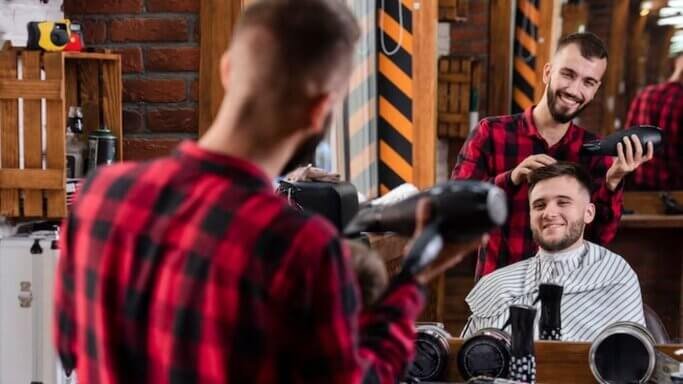Barbering, a craft practiced and perfected over thousands of years, has a rich and intricate history. Its evolution, from the ancient societies to the modern, sleek barbershops of today is like a barbershop that is a fascinating tale of tradition, ingenuity, and artistry.
Barbering in Ancient Civilizations
In ancient civilizations such as Egypt, Greece, and Rome, barbering was considered a respected profession. Barbers were tasked not only with grooming but also held significant societal roles. Their workspaces were hubs of social interaction and often political discussion.
The Tools of Ancient Barbers
Despite the limited technology, ancient barbers managed to create grooming tools to serve their purposes. For instance, they utilized sharpened flints, oyster shells, and bone as rudimentary razors and tweezers. Even in such early periods, the craft of barbering was marked by resourcefulness and adaptability.
Barbering in the Middle Ages and Renaissance
As societies evolved, so did the role of barbers. During the Middle Ages and the Renaissance, they became ‘barber-surgeons’, performing minor surgical procedures in addition to hair cutting and shaving. However, by the end of the Renaissance, the professions of surgeons and barbers began to separate, pushing barbers further into the realm of grooming and styling.
The Birth of the Modern Barbershop
The 18th and 19th centuries saw the birth of the modern barbershop. Specializing in men’s grooming, these establishments offered haircuts, shaves, and even wig styling. The barbershop became a place for men to gather, socialize, and discuss current events, marking a return to its roots as a social hub.
Evolution of Barbering Tools
The advent of the modern barbershop also brought improvements in barbering tools. The straight razor became a staple, and scissors were refined for hair cutting. Innovations in steel production allowed for sharper, more durable tools, elevating the precision and quality of barbering services.

The 20th Century and Beyond
The 20th century brought considerable changes to barbering. Influences of world wars, cultural shifts, and technological advancements shaped the industry. The profession saw the rise of women barbers and a diversification of services to include hair coloring, perms, and hair treatments.
The Contemporary Barbering Scene
Today’s barbering scene is a blend of tradition and modernity. Current trends and styles are often rooted in historical techniques, yet executed with the latest tools and products. Technology and product innovation have revolutionized the industry, with electric clippers and modern shaving products becoming commonplace in barbershops.
- Electric Clippers: For efficient and precise hair cutting.
- Razors: From straight razors for traditional wet shaves to safety razors and cartridge razors for different levels of comfort and closeness.
- Styling Products: Gels, pomades, waxes, and creams to cater to a range of hair types and style preferences.
Modern Barber Training and Education
The path to becoming a barber in the 21st century is significantly different from the ancient apprenticeship system. Today’s aspiring barbers undergo extensive education and training in accredited institutions, a testament to the complexity and importance of this profession.
These institutions offer comprehensive programs covering a broad spectrum of subjects. This includes learning practical skills such as haircutting, shaving, and grooming, where students are trained to master various tools and techniques.
In addition to the hands-on training, theoretical knowledge forms a critical part of the curriculum. Students delve into topics like hair and scalp diseases, learning to identify common issues and when to refer clients to healthcare professionals.
Sanitation and sterilization protocols are stressed upon, given their importance in maintaining a safe and healthy environment in the barbershop. Business management is another key area of study, equipping future barbers with the necessary skills to run a successful top barbershop or become a sought-after professional in a high-end salon.
Upon completion of their education, many regions require barbers to obtain licensure before they can practice. This typically involves passing a state board examination, which tests both theoretical knowledge and practical skills. The licensure process ensures that barbers meet the industry standards and are well-equipped to provide their clients with safe and high-quality services.
Technology and Barbering

In the modern world, the influence of technology on every industry is apparent, and barbering is no exception. Technological advancements have revolutionized the way barbers work, elevating the standards of services and the overall client experience.
For instance, electric clippers, a staple in every contemporary barbershop, enable barbers to provide faster and more precise cuts compared to manual scissors. Advanced shaving products and hair care solutions, developed through scientific research, allow barbers to cater to a range of hair types and style preferences while ensuring the health of the hair and scalp.
Technology has also streamlined the operational aspects of the barbershop. Online booking systems have made appointment scheduling and management a breeze, saving time for both the barbers and the clients. Digital payment solutions offer clients the convenience of cashless transactions.
Even marketing and client engagement have been transformed with the advent of social media. Barbers can showcase their work on platforms like Instagram, attract potential clients, and build a strong online presence. They can also use these platforms for professional development, learning new techniques, and staying updated with the latest trends from fellow barbers worldwide.
The marriage of technology and barbering continues to shape the industry, promising exciting possibilities in the future. As barbers adapt to these changes and incorporate new technologies into their craft, the essence of barbering – the commitment to grooming and personal care – remains constant.
This fusion of tradition and innovation is beautifully manifested at the barbershop, where we proudly carry forward the rich heritage of this craft while embracing the conveniences of the modern world.
Conclusion
The craft of barbering has evolved immensely, from its ancient roots to the modern barbershop. This historical journey highlights the richness of the craft, adding depth to our appreciation of a well-executed haircut or shave. At barbershop, we embody this fusion of tradition and innovation, inviting you to experience the modern rendition of this historic craft.
Recommended Articles: